Authors:
Colonel Viacheslav Semenenko PhD, the Deputy Head of the Center for Military and Strategic Studies of the National Defence University of Ukraine, Kyiv, Ukraine
Colonel (ret.) Andrii Ivashenko PhD, leading researcher at the Center for Military and Strategic Studies of the National Defence University of Ukraine named after Ivan Cherniakhovskyi, Kyiv, Ukraine
Izvorni znanstveni rad (Original Scientific Paper)
Received: 14 February 2022
Accepted: 1 March 2022
DOI: https://doi.org/10.37458/nstf.23.2.2
Abstract
The article examines Russia's political goals and military scenarios for Ukraine, as well as options for supporting Ukraine that are available to the United States, its allies and partners in the event of an invasion. New developments and information need further analysis to better understand Russia's intentions and consequences.
Keywords: Hybrid warfare, Ukraine, Russian Federation, Military power, Russian aggression, Possible Scenarios

Introduction
Russia has a two-pronged approach to Ukraine, combining a significant increase in conventional forces with non-military operations aimed at undermining Ukraine's economic, political and military independence.
According to IDP estimates and new satellite imagery, Moscow has prepared a large number of ground, naval, air and air units and troops for a possible invasion of Ukraine and has organized its own intelligence services and special operations forces to conduct large-scale cyber operations, sabotage and sabotage. If the peace talks fail, the escalation between the North Atlantic Treaty Organization (NATO) and Russia could go far beyond Eastern Europe and include global responses.
To better understand recent events, the article addresses two main issues:
1. Which includes Russia's hybrid strategy;
2. What should be the strategy of counteracting Ukraine, the United States, allies and partners of Russia's hybrid aggression?
To answer these questions, an analysis of the latest satellite images of Russia's land, air and sea forces was conducted; studied information from open sources about the usual and irregular activities of Russia, assessed options for Russian invasion. The article is based on a database of Russian aggression and OSINT investigations. Based on this analysis, there are three main arguments:
1) Russia surrounded Ukraine on three sides with conventional invading forces (Fig. 1) which poses an immediate threat to Ukraine. In addition, Moscow has prepared the Russian Air Force and Navy to support a possible ground invasion;
2) Russia can also conduct a wide range of non-military operations in Ukraine and against the West, including cyber operations, subversive activities and sabotage by Russian special services and special operations forces. These actions could go far beyond Eastern Europe, such as Russian cyberattacks on critical US infrastructure and subversive operations against submarine fiber optic cables;
3) The United States and Western partners need to develop a strategy that combines deterrence and coercion. If Moscow invades or otherwise strengthens its position in Ukraine or other regions, the United States and Western partners must be prepared for major diplomatic, economic, military and informational efforts to protect NATO's eastern flank, preventing Moscow's annexation of additional territories as in Ukraine. and in other Eastern European countries.
I. Hybrid strategy of Russia
Russia's political goals include:
1. restoration of the union state and the western borders of Russia as of 1992;
2. a halt to NATO's further eastward expansion;
3. curtailment of previous NATO enlargement;
4. withdrawal of US nuclear weapons from Europe;
5. expanding Russia's sphere of influence.
Ukraine plays a particularly important role in Moscow's strategic calculations as Ukrainian leaders increasingly shift their economic, political and military loyalty to the West. In addition, President Vladimir Putin, in his July 2021 article on the historical unity of Russians and Ukrainians, which was mandatory for all Russian servicemen, argued that Russia and Ukraine are one. "Together we have always been and will be much stronger and more successful," Putin wrote. "For we are one people"
Fig. 1 Location of Russian troops near Ukraine as of February 2, 2022
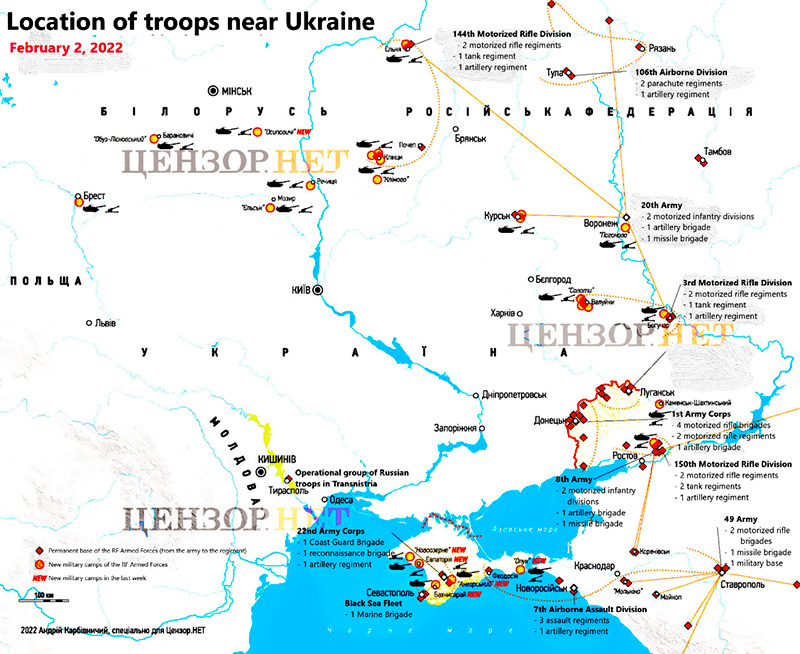
1.1 Military component of Russia's hybrid strategy
Based on political goals, Russia has at least seven options for achieving them.
1. Redeploy ground forces from the border with Ukraine, but continue to assist pro-Russian separatists in Ukraine, conduct offensive cyber operations and engage in other non-military operations in Ukraine and the region.
2. Introduce Russian troops into the territory of the temporarily occupied districts of Donetsk and Luhansk regions.
3. Occupy the territory from the eastern borders of Ukraine to the Dnieper River.
4. Capture Ukraine to the Dnieper and an additional strip of land to connect Russia with Transnistria along the Black Sea (Fig. 2).
5. Capture only the strip of land between Russia and Transnistria along the Black Sea (Fig. 3).
6. Capture the whole of Ukraine (Fig. 4).
7. Get on the current line of strategic defense of the union state (Fig. 5)
Fig. 2. Scenario 4: Capture of Ukraine to the Dnieper and an additional strip of land to connect Russia with Transnistria along the Black Sea
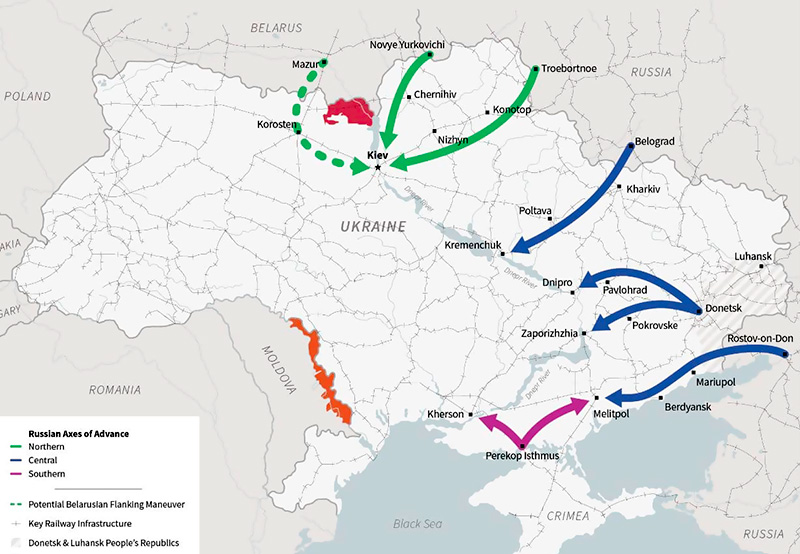
Fig. 3. Scenario 5: Capture of the land strip between Russia and Transnistria along the Black Sea
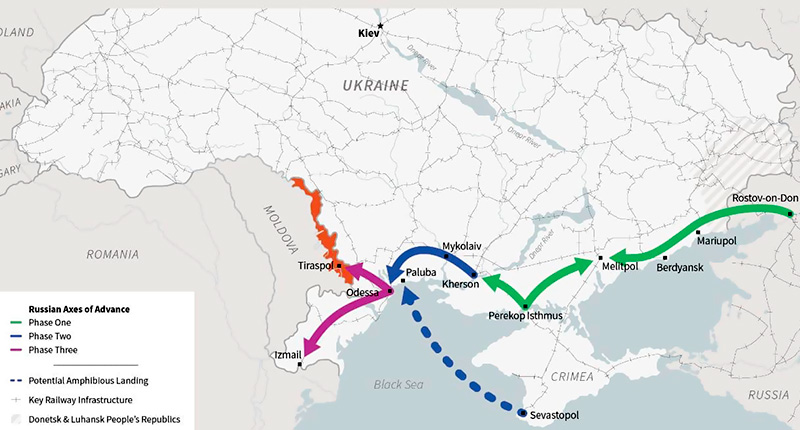
Fig. 4 Scenario 6: capture of the entire territory of Ukraine
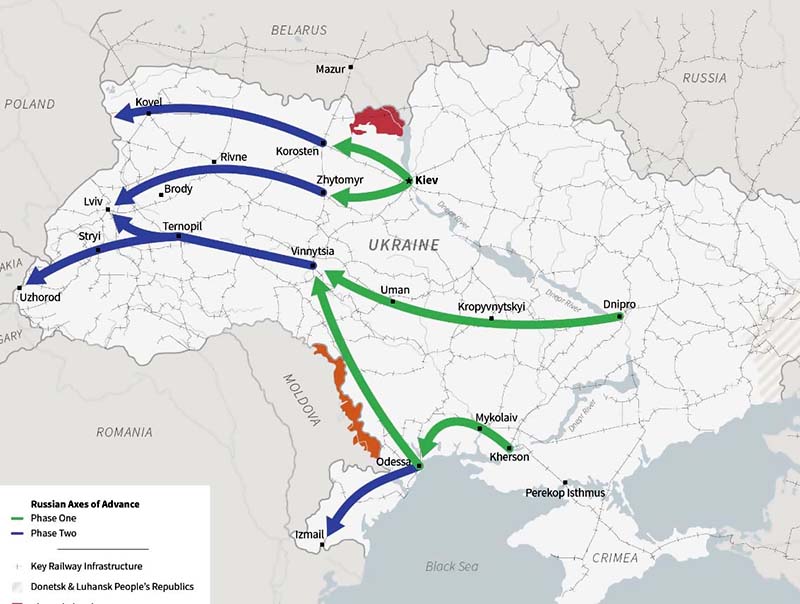
Fig. 5 Scenario 7: Ensuring the current line of strategic defense of the Russian Federation, including the capture of the Suwalki Corridor
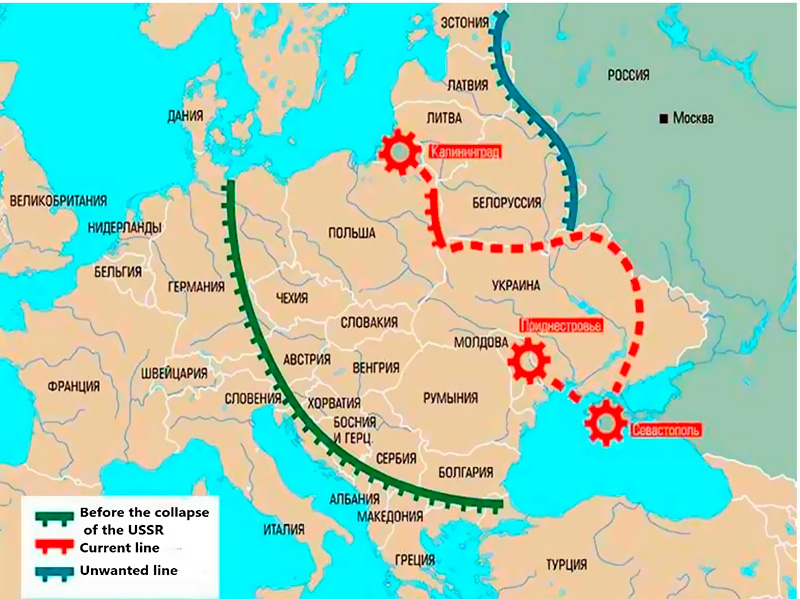
Most of these options are implemented by conducting a general military operation, which the Russian army has worked out and improved in Syria. Russia has developed and adopted advanced field control, communication and reconnaissance (C3I) systems, which increase the number of air strikes to support ground forces. Russia's new C3I systems are integrated with reconnaissance and strike systems designed to coordinate the use of high-precision long-range weapons with real-time intelligence and accurate targeting. Russia has improved these technologies and integrated them into unmanned aerial systems such as Orlan-10, Outpost and Eleron-3C, electronic warfare systems and other reconnaissance, surveillance and reconnaissance (ISR) systems.
Moscow has positioned its armed forces so that they pose a direct threat to Ukraine (Fig. 1-4).
1.1.1 Russian armed forces near the borders in eastern Ukraine.
Russia's armed forces near the Russian-Ukrainian border include critical invasion forces, such as major battle tanks, self-propelled howitzers, towed artillery, multiple rocket launchers, anti-aircraft missile systems, short-range ballistic missiles, and more.
Thus, the 144th Guards Motorized Rifle Division (Yelnya), in the period from early November 2021 to the end of January 2022, significantly increased the number of military equipment. The Russian military built at least eight new field camps. The number of vehicles, trailers and structures at these points increased by 45%. The number of tanks, self-propelled howitzers and other weapons systems in two different formations increased by 24 and 25 percent, respectively.
The 41-strong Army (Yelnya) consists of about 450 tanks, self-propelled artillery units (SPAs), armored personnel carriers (APCs), towed artillery units, and multiple rocket launchers (MLRS). This army includes surface-to-air missiles (SAM), short-range ballistic missiles and support vehicles. This is about 24 percent more than on November 9, 2021.
This set of troops includes about 510 tanks, the Armed Forces, MLRS, armored personnel carriers and support vehicles. This is about 25% more than on November 9, 2021.
These eight connections were added on November 9, 2021 and contain about 460 machines, trailers and structures.
1.1.2 Russian armed forces on the territory of the Republic of Belarus
On January 18, 2022, the Interfax-Military News Agency reported on a two-stage joint exercise of the Allied Resolve 2022 Russian and Belarusian armed forces. The first stage is air defense training, for which 12 (twelve) Su-35C fighters , two S-400 anti-aircraft missile divisions and one Pantsir-S short-range anti-aircraft missile division have been sent to Belarus. The second stage of training will take place from 10 to 20 February (the last day of the Olympic Games in Beijing). The entire 45,000-strong Belarusian army will work with 30,000-35,000 Russian troops transferred to Belarus from the Far East. This is the first in the history of strategic training, which the Belarusian army conducts in full force in winter, and the Belarusian armed forces have never conducted training of this scale, even in summer. Russia has used a wide range of weapons in accordance with the Eastern Armed Forces to participate in training: Su-35C fighters, Su-25 attack aircraft, Iskander-M missile defense system, Uragan missile defense system, S-400 SAM, Pantsir-S missile defense system and REB complex. Beauty-4 ”.
The stated goal of "Allied Resolve 2022" - "working out the tasks of suppression and reflection of external aggression in the conduct of defense operations, counter-terrorism and protection of the interests of the Union State". An integral part of the training is to practice actions in cyberspace on deployment and actions of grouping troops (forces). educational tasks in cyberspace, some of them may be real against the infrastructure and public resources of other countries [Ministry of Defence Ukraine].
On February 2, 2022, the Armed Forces of the Russian Federation and the Republic of Belarus launched a joint strategic military exercise "Allied Resolve 2022", which takes place at the "Domanovsky", "Gozky", "Obuz-Lisnovsky", "Brest" and "Osipovichsky" and 4 airfields. Fig. 6) [Проверка сил реагирования Союзного государства. Минобороны России. Министерство обороні России. https://structure.mil.ru/mission/practice/all/rehimost-2022.htm]
Fig. 6. Objects of military infrastructure of the Republic of Belarus, declared for training "Allied Resolve 2022" (source - Ministry of Defense of the Russian Federation)
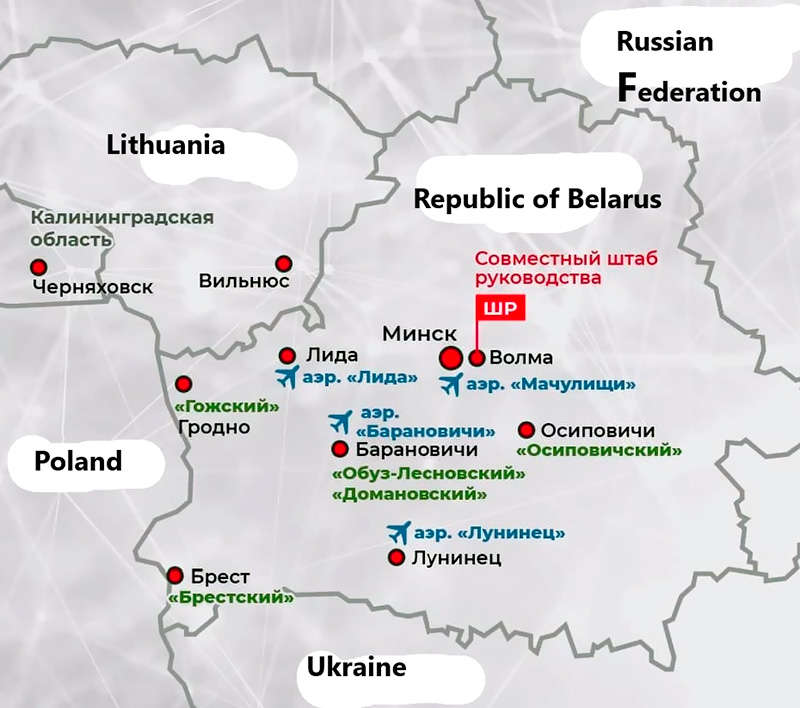
There is growing evidence that Russian troops not only arrived in Minsk but also passed through Gomel, an important railway and road junction north of Kyiv, in areas just outside Ukraine. As of today (January 3, 22), Russian troops have formed a field camp near the town of Rechitsa in the Gomel region, which is located near the E95 highway at a distance of 300 km north of Kyiv (40 km to the Chernihiv border, 90 km to the Kyiv border). Hurricane jet fire systems have been recorded in the field camp. Thus, a number of Russian military equipment is located near the border with Ukraine, away from any military training grounds associated with the Allied Resolve exercise (Fig. 7).
Fig. 7 Geography of the location of the Russian Armed Forces at the joint exercises "Allied Resolve 2022"
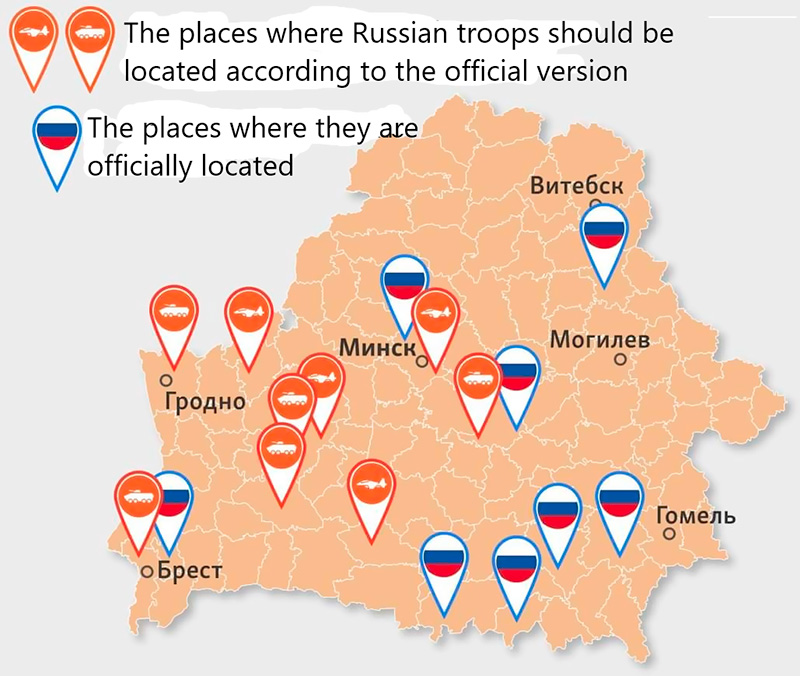
Deployment of Russian troops in the south-eastern regions of Belarus is carried out in convenient proximity to 4 large warehouses / logistics facilities and the Mozyr Oil Refinery (Fig. 8). As for Mozyr, Russian troops have already connected to the local pipeline.
Fig. 8. Warehousing and logistics facilities on the territory of the Republic of Belarus
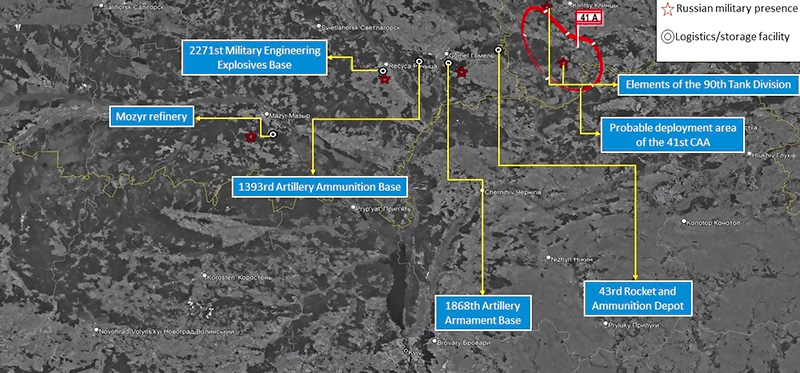
During 2015-2020, the Belarusian authorities carried out work on the construction and modernization of roads that can be used for military purposes. Thus, a number of access roads have been created from the M10 Brest-Gomel highway in the direction of the border with Ukraine, the length of which is about 96 kilometers.
Access roads were created to:
- border checkpoint "Olmany", bordering on the village of Perebrody, Dubrovytsia district, Rivne region;
- border post "Mutvytsia", bordering the village of Drozdyn;
- border post "Khinichiv", bordering on the village of Zabolottya;
- the Selishche checkpoint bordering the village of Poznan Rokytne;
- on the territory of the Belarusian reserve "Olman bogs", located in the border Stolin district of Brest region;
- in the Chernihiv direction - in forest belts that directly approach the Ukrainian border.
All these objects are of military importance only. In the immediate vicinity of these parts of the Belarusian-Ukrainian border are the Ukrainian cities of Chernihiv, Zhytomyr, Novograd-Volynsky, in dangerous proximity is Kiev.
Based on this, one of the possible options for Russia's actions is an offensive from the flank along the line Mozyr (Belarus) - Korosten (Ukraine) - Kiev in order to capture Kiev (Fig. 2). Allied Resolve 2022 exercises provide cover for Russian forces for this maneuver, but may serve several other purposes.
At the same time, as of February 10, 2022, the number of districts of the Republic of Belarus in which training is conducted has doubled.
Another option for Russian troops is to capture the Suwalki Corridor, a 100-kilometer stretch of land between Lithuania and Poland. This corridor is of strategic importance to the North Atlantic Alliance, which connects the country with other mainland NATO members and is the main destination for the transfer of troops to the Baltic Allies and their armaments.
Named after the Polish city of Suwalki, the corridor is strategically vulnerable due to the fact that it is trapped by the Russian enclave, the Kaliningrad region, the northwest and the territory of Belarus to the southeast. For this reason, he is the perfect mix for Russia's attack.
Fig. 9 Places of deployment of the training program "Allied Resolve 2022" as of February 10, 2022, according to the RF Ministry of Defense.
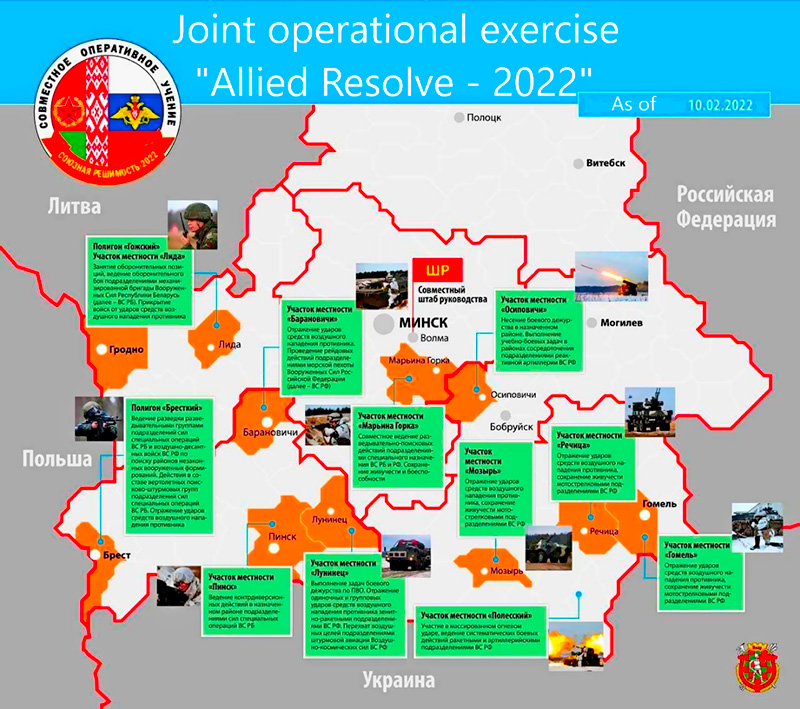
"The Suwalki Corridor is a gathering place for the weaknesses of NATO's strategy" [Hodge, Bugaisky, Doran. From the Center for European Policy, 2018] The Suwalki Corridor is the zone most vulnerable to Russian aggression on NATO's borders. The Baltics together have a population of only 6.6 million and cannot stop the Russian population on their own. The seizure of this territory will separate the Baltic States from the Allies, paralyze communication, and complicate military and humanitarian aid. The Russian Armed Forces are able to capture the capitals of Estonia and Latvia in sixty hours [RAND, 2016]. Thus, for the Alliance, there is a real retention of control of Poland and Lithuania.
Russia's S-300 and S-400 air defense systems, deployed in Kaliningrad and near St. Petersburg, in combination with missile defense systems in Belarus, are capable of blocking airspace in most of the Baltic states and Poland (Figure 10). Thus, the Armed Forces of the Russian Federation, together with the Armed Forces of the Republic of Belarus, are able to block the Suwalki Corridor and the nearest country not only by land but also in the airspace.
Fig. 10. Russia's S-300 and S-400 air defense systems, deployed in Kaliningrad and near St. Petersburg, combined with Belarus' air defense systems, are capable of blocking the airspace of the Baltic States and Poland.
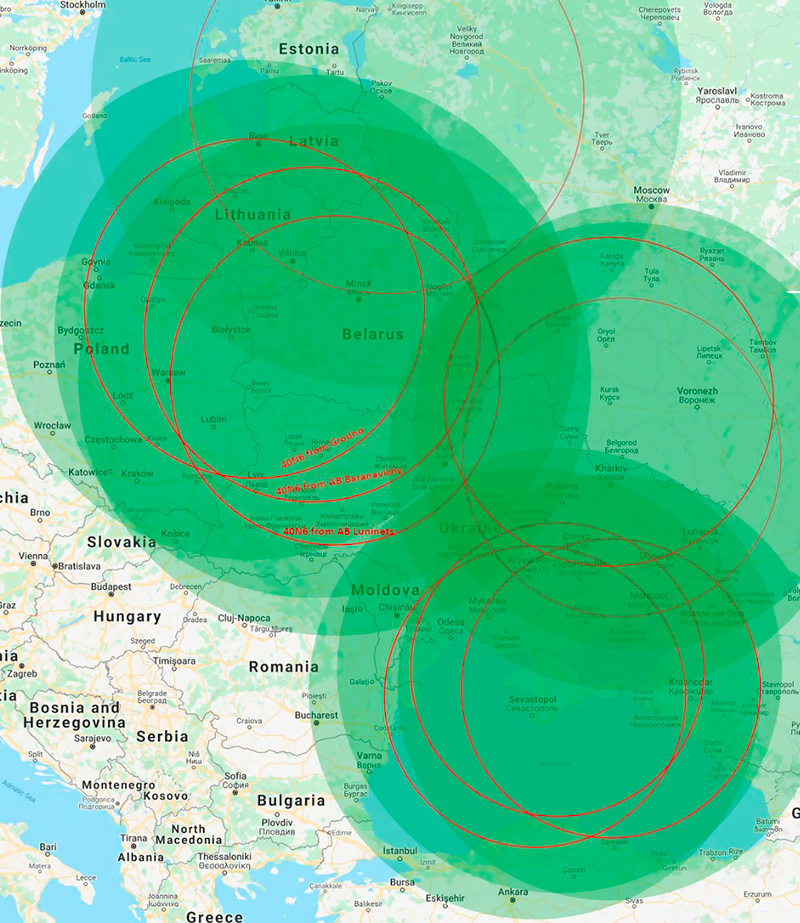
Conclusions on the deployment of Russian troops in the Republic of Belarus during the joint exercise "Allied Resolve 2022":
1. The deployment of Russian troops in Belarus complicates Ukraine's defense, forcing it to hold reserves along its northern borders in response to both a possible flank attack on Kyiv and attacks to the west. The Poles marveled at a similar situation in 1939, when Nazi troops captured parts of post-Munich Czechoslovakia, encircling Poland on three sides.
2. The deployment of Russian troops in Belarus may indicate an intention to invade Ukraine further than just the eastern bank of the Dnieper or along the Crimean coast (Fig. 3). Crossing the Dnieper will put the Ukrainian Armed Forces in a difficult position of defense against Russian troops advancing from two different directions.
However, the offensive to the south, deep into Ukraine from the Belarusian border, is fraught with difficulties. This area, known as Polissya bogs (or Pripyat bogs), consists of 104,000 square kilometers of dense forests, swamps, lakes and rivers. Several spaced-apart roads (including north-south roads) cross the area. The terrain is extremely difficult for this type of armored vehicles, which is in service with the Russian army. In many ways, the area is ideal for deterring the occupiers.
3. The alarm of the entire Belarusian army and the deployment of Russian troops in Belarus may indicate Minsk and Moscow's fears about NATO's implementation in the event of war with Ukraine. The flare-up of the Russian Armed Forces may be aimed at ensuring that Belarus is protected from NATO air, and that it has arisen as a result of what is happening to Russia with the growing military presence on its territory.
1.1.3 Russian armed forces on the territory of the tempo-rarily occupied Crimea
The limited capacity of the Russian Black Sea Fleet (approximately two battalion tactical groups (BTG) at a time), as well as the vagaries of agreeable and maritime conditions, including hydrography and topography, the problem of maintaining air superiority over the bridgehead, and logistics problems - create landing operations along Black Sea coast risky business.
Table 1: Shock group of ships of the Russian Navy in the Black Sea,
|
No
|
Type
|
Name
|
Fleet
|
|
1
|
cruiser
|
Varangian
|
|
|
2
|
cruiser
|
Moscow
|
|
|
3
|
cruiser
|
Marshal Ustinov
|
|
|
4
|
frigate
|
Admiral Grigorovich
|
|
|
5
|
frigate
|
Admiral Makarov
|
|
|
6
|
frigate
|
Admiral Essen
|
|
|
7
|
frigate
|
Admiral Kasatonov
|
|
|
8
|
БПК
|
Admiral Tribute
|
|
|
9
|
БПК
|
Admiral Kulakov
|
|
|
10
|
БДК
|
Queen
|
Baltic Fleet
|
|
11
|
БДК
|
Minsk
|
Baltic Fleet
|
|
12
|
БДК
|
Kaliningrad
|
Baltic Fleet
|
|
13
|
БДК
|
Olenegorsky miner
|
Northern Fleet
|
|
14
|
БДК
|
George the Victorious
|
Northern Fleet
|
|
15
|
БДК
|
Peter Morgunov
|
Northern Fleet
|
|
16
|
БДК
|
Yamal
|
|
|
17
|
БДК
|
Azov
|
|
|
18
|
БДК
|
Caesar Kunikov
|
|
|
19
|
БДК
|
Novocherkassk
|
|
|
20
|
БДК
|
Nikolai Filchenkov
|
|
|
21
|
БДК
|
Saratov
|
|
|
22
|
БДК
|
Orsk
|
|
|
Special
reconnaissance ships
|
|
23
|
SRS
|
Vasily Tatishchev
|
Baltic
Fleet
|
(without small missile and small anti-aircraft ships)
Medium reconnaissance ship SSV-231 "Vasily Tatishchev" of project 864 of the Baltic Fleet of the Russian Navy. In 1988 joined the Navy. It is part of the 72nd Separate Division of Special Purpose Ships of the Baltic Fleet Intelligence Center. In 2015, the ship completed repairs. As a result, we received the SAILOR communication system and the Centavr-NM2S satellite communication ship station. In 2015 and 2017, the ship performed combat missions for a long time in the waters of the Atlantic Ocean and the Mediterranean Sea. In July 2017, a participant in the parade on the occasion of the Day of the Russian Navy in Tartus (Syria). In 2018, a participant in the Navy parade in Baltiysk. Regularly involved in maneuvers in the Baltic Sea. In April 2019, he completed tasks in the Baltic Sea.
As shown in Table 1, Russia has a naval force in Sevastopol, available for landing operations - 197 landing craft, which includes seven large landing ships of the II rank of projects 775 / 775M Ropucha (4) and project 775 (3). In addition, six naval landing ships of the Northern and Baltic Fleets continue to move in the Mediterranean Sea in the direction of the Bosphorus and Dardanelles. These ships, when they enter the Black Sea , will increase the landing capacity of the Black Sea Fleet by about 1-1.5 reinforced BTG.
For the first time since 1991, the Russian Navy has assembled such a powerful group on NATO's southern flank: 3 Atlant 1164 missile cruisers, 4 missile frigates, two large anti-shuttle ships, and 13 large landing craft.
This increase in capacity reduces, but does not eliminate, Russia's risks of landing operations off the coast of Ukraine. The increase in combat power on the shore in the first wave of assault from 2 to 3.5 BTG provides a larger area of the bridgehead. But these actions do not eliminate such obstacles, including the limited number of suitable beaches for the landing of armored vehicles and the turnaround time from the landing of the first wave to the delivery of the second and third waves from the Crimean ports. In order to capture the city of Odessa, Russia can send its landing ships directly to the port of Odessa and land directly in the city. In combination with an airborne attack on the city airport and a helicopter attack to capture key points in the city, a direct attack can be successful. However, the amount of combat power of 3.5 BTG Marines landing on the shore, another BTG Marine landing from helicopters, is not enough to maintain the city.
The airborne BTG of the Russian army, landing at one of the nearest airports, will number only from 6,000 to 7,500 soldiers. Odessa has a population of millions, and city battles help defenders. These forces will be alone until the naval task force is able to return to land in the second wave. In addition, if the Ukrainian air defense is not destroyed, reinforcements from the air will be problematic. Even if these landings are backed by air and sea, they will still be in a precarious position until a connection is made with units of the Russian army that will break through from the east. Therefore, any airborne and air attack on Odessa would be strategically advantageous, but also a high-risk operation.
Another option for using increased landing capacity is to bypass the Ukrainian defense along the Perekop Isthmus and land on the west coast of Kherson region. Three Marine BTGs, landed on the shores of the Perekop Isthmus and supported by airborne and airmobile forces, could bypass the Ukrainian defense on the flank and allow Russian troops in the Crimea to break into southern Ukraine. However, on this part of the coast of the Kherson region there is only one section with a length of about 20 km between the cities of Lazurne and Zalizny Port, the hydrography of which allows the mooring of Russian landing craft. Other coastal areas are either too small or inaccessible due to coastal barrier islands. None of these problems are insurmountable, but the costs of overcoming them can be high.
Fig. 11 Naval blockade of Ukrainian ports, announced by the Russian Federation
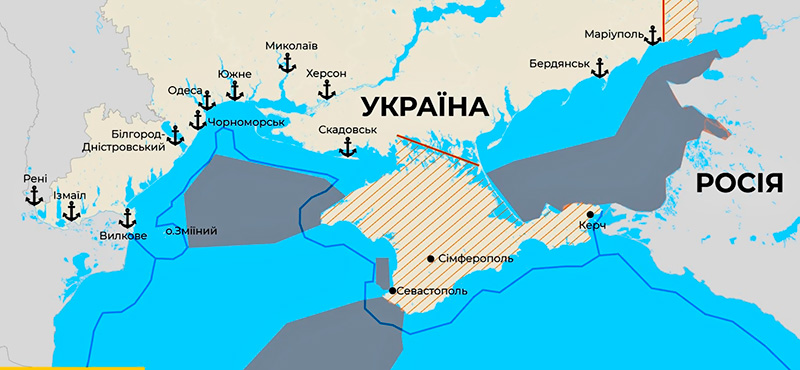
On February 9, the Russian Federation made an official announcement about the closure of the Black and Azov Seas from February 13 to 19, 2022, under the pretext of conducting military exercises with shootings. The area of maneuvers makes it virtually impossible for Ukraine to navigate both seas. This is an unprecedented step by Moscow. Such actions are of particular concern, especially given the tensions on the land borders with Russia and Belarus.
At the same time, for unknown reasons, the Russian military began to conduct underwater technical work in one of the areas prohibited for navigation to clean the marine scattering exits of the transport crossing through the Kerch Strait. Such work is carried out in conditions of strict secrecy with a ban on the use of radio communications.
At the beginning of February 2022 on the basis of the 561st Emergency Rescue Center of the Russian Federation (Sevastopol) tests were conducted without a crew vessel of unknown design. The Center is also used not only to train rescue divers, but also to train Special Operations Forces, namely combat swimmers who have the skills to destroy ships and coastal infrastructure (bridges, berths, etc.).
The above facts take place against the background of a powerful information campaign of the Russian Federation with fakes about "terrorist threats from Ukraine". These data complement the assumption that the Russians are preparing to, if necessary, and make a political decision, to carry out a provocation by blowing up bridge piers and further accusations of this to the Ukrainian side.
After exposing the signs of preparation for Russian provocations, the Russian Federation announced the prompt release of (water and air) areas of the Kerch Strait. Well, if it is done under pressure from the international community. It is bad, if this was their plan, to first close certain eyes to the preparation of the sabotage, and then, when it is prepared - to open certain areas so that everyone is closely watching what may happen next.
1. Russia continues its military demonstration near the borders of Ukraine, and the number of deployed forces exceeds the number of Russian troops near the borders of Ukraine in 2014 and April 2021. Deployment takes place on the widest possible front along the entire border with Ukraine and on the territory of Belarus under the legend of long maneuvers.
2. The actions of Russian troops are threatening, but to withdraw these forces from the bases and go on the offensive, the enemy will need two days. Such a threatening approach will be noticed in advance by Ukraine's intelligence and NATO's intelligence. With each passing day of the slow concentration of Russian troops in these actions, there is more and more political demonstration. But this does not mean that it is a pure game - because in order for this game to turn into blood, it takes a little effort.
3. The danger is not only that Putin is demonstrating. Another danger is that in April 2021, Russia completed the deployment of rapid reaction units, such as airborne troops, which do not participate in this deployment. And now Russia is working on the deployment of its relations with Siberia and the Far East. That is, the individual components are working together to carry out an attack on Ukraine, and if necessary, can be used simultaneously.
4. Analyzing this not as political pressure, but as preparation for a real military invasion, it is like masking the enemy's direction of concentration of major efforts. The enemy is trying to attract attention and stretch the Ukrainian cover forces to facilitate action in the chosen direction. NATO's response shows that the Russian army cannot achieve an operational surprise. But tactical suddenness in some local areas can be achieved.
5. Given the contours of the deployment of the most dangerous for offensive operations of the RF Armed Forces was and remains the front in the Donbass. From both a political and a military point of view, local strikes in the Donbas can be seen as a desirable scenario for Russia to escalate by force if attempts to exert political pressure fail. For such local strikes, it is not necessary to create a large group in advance. Enemy forces, which have been deployed and reinforced in advance by two new military camps, have already created the necessary infrastructure for local operations and may be accumulating on the front lines covertly. That is why the front in Donbass continues to demand the most attention.
6. Although President Joe Biden and Prime Minister Boris Johnson have announced that they will not deploy US or British forces in Ukraine, Russia and Belarus may be concerned about NATO's intervention, however unlikely it may be.
7. The greatest influence of the Russian Black Sea airborne forces on any future conflict can be provided simply by their presence. The airborne task force will link Ukrainian reserves near Odessa and Kherson, just as forces in Belarus will force Ukraine to keep reserves in the north and away from fighting near Kyiv and along the Dnieper. While attacks through Polissya swamps and Black Sea beaches can be difficult and costly, Ukraine cannot ignore such scenarios and leave these areas unprotected.
1.2 Non-military component of Russia's hybrid strategy
Russia can conduct a range of cyber and other non-military operations against Ukraine and the West, including cyber espionage, information and disinformation operations, and subversive cyber attacks. For example, on January 14, 2022, hackers hacked the official website of the Ministry of Foreign Affairs of Ukraine, where they posted messages in Polish, Russian and Ukrainian: "Fear and wait for the worst." During a separate cyberattack, data from dozens of computers belonging to several Ukrainian government agencies were completely erased.
Recent news sources, citing intelligence reports, have suggested that Belarusian proxies may have played a role in the attacks. However, cyber warfare is unlikely to linger in Ukraine. In 2017, a Russian cyberattack called "NotPetya" against Ukrainian private companies spread to computers and servers around the world, causing billions of dollars in damage. NotPetya affected international seaports, multinational companies and almost all those who paid taxes or did business with Ukraine. The West can expect such attacks if Russia invades Ukraine. However, this time the cyberattacks are likely to target the United States and other Western government and private sector facilities, not just through the spread of malware. If the United States and its allies and partners impose economic sanctions on Russia for another attack on Ukraine, the Kremlin may retaliate by imposing its own economic sanctions on the West through cyberattacks, including on the financial sector.
Russian intelligence and the Ministry of Defense also support paramilitary formations in Ukraine designed to carry out sabotage and subversive activities. The highest density of Russian-backed paramilitaries is probably in eastern Ukraine.
Russia provided tanks, small arms, mobile artillery, fuel, training, and other assistance to the separatist insurgents. Russian forces helped create, support and fund separatist political parties in Ukraine; creating and supporting paramilitary groups such as the Russian Orthodox Army and the Night Wolves; recruited Don Cossacks, Chechen, Serbian and Russian mercenaries for paramilitary formations to fight in Ukraine.
Russian aid to separatist groups in Ukraine appears to be growing. One of the uses of these groups may be sabotage and other irregular hostilities or "fifth column" operations in the capital, Kyiv, or in the rear of the Ukrainian armed forces, while Russian regular forces will launch an offensive from the east.
In addition, the Kremlin has developed plans to establish a pro-Russian leader in Ukraine, according to British intelligence, possibly through a coup.
Russia can also carry out other types of sabotage and subversive activities in Europe in response to Western sanctions. For example, Russia's military and intelligence services may be targeting submarine fiber-optic cables connecting Europe and North America. This large cable network runs across the Atlantic and provides text messaging, calls, global financial transactions and the Internet. Approximately 97 percent of all intercontinental data is transmitted by these cables. In January 2022, Russian naval ships conducted military exercises off the coast of Ireland and in close proximity to fiber optic cables, raising concerns about Russian sabotage. Russia may also focus on other European countries, such as fiber-optic cables between mainland Norway and Svalbard, which are controlled by Norway. In January 2022, Admiral Sir Tony Radakin, Chief of Staff of the United Kingdom's Defense Staff, warned that Russian ships, including submarines, could cut important submarine communication cables.
Finally, Russia may also try to take a number of economic measures, such as affecting oil and gas prices and banning the export of titanium, copper, wheat and corn to Western markets.
Escalation in Donbass could leave the Middle East without food. According to the Food and Agriculture Organization (FAA), about half of all wheat consumed in Lebanon in 2020 came from Ukraine. Of the 14 countries that consume more than 10% of wheat from Ukrainian imports, many are already facing food insecurity due to political instability or ongoing violence. For example, Yemen and Libya import 22% and 43% of Ukraine's total wheat consumption, respectively. Egypt, the largest consumer of Ukrainian wheat, imported more than 3 million metric tons in 2020, which is about 14 percent of total wheat. According to the FAA, in 2020 Ukraine also provided 28 percent of wheat consumption in Malaysia, 28 percent in Indonesia and 21 percent in Bangladesh [
https://foreignpolicy.com/2022/01/22/russia-ukraine-war-grain-exports-africa-asia/]
1.3 The nuclear dimension of Russia's hybrid strategy
Among the military equipment that arrived in Belarus from the Far East of Russia was an echelon of equipment, probably from the 16th Brigade of Radiation, Biological and Chemical Protection. The Russian military believes that the deployment of this unit is more important than others. It is logical to assume that Russian leaders expect that it may be needed and used.
The Chornobyl Exclusion Zone is an area of 1,000 square kilometers north of Kyiv. To the north of it, in Belarus, is the Polissya State Radioecological Reserve with an area of 835 square meters. km. Both facilities were created as a result of the 1986 Chernobyl accident. The main danger for people visiting the area is the impact of radiation entering the soil, and visitors are warned not to sit on the ground or touch plants as a precaution. The presence of the RHB unit in Belarus may indicate that the Russian military plans to shorten its route to the Ukrainian capital by passing through the edges of the exclusion zone instead of advancing along the Mozyr-Korosten-Kyiv axis. Military action in these areas, such as the movement of wheeled and tracked vehicles on dirt roads, would shake the ground and expose soldiers and equipment to residual radiation after the 1986 disaster. If Ukrainian forces defended the Chornobyl Exclusion Zone, infantry would have to disembark from their vehicles and fight, perhaps for several days, in the forests and fields of the zone. Infantry on both sides must dig trenches and live in them for several days in conditions of residual radiation. However, this scenario justifies the expediency of deploying RHC decontamination units in Belarus and the possible reason for their presence.
The Russians could also deploy RHC decontamination units for another reason - the danger of nuclear contamination from Ukrainian nuclear power plants damaged during hostilities. Ukraine has 15 operating nuclear reactors at four nuclear power plants, which produce a quarter of the country's electricity. The nuclear power plant in Zaporizhia on the east bank of the Dnieper is one of the largest in the world and may be in the direct path of a central strike by Russian troops through Ukraine. The other three stations are located west of the Dnieper, two near Ukraine's border with Belarus, and another about 80 miles northeast of Odessa. Decontamination units are likely to be involved in the worst-case scenario in which Russian forces could operate in or around nuclear-contaminated areas. The melting of the Chernobyl-style reactor core due to the fighting would not only endanger locals and nearby soldiers on both sides, but easterly winds would bring radiation to Russia. This is especially true of any damage to six reactors in Zaporizhia, which is about 200 km from the Russian border and less than 125 km from Donetsk.
II. Strategy to counter Russian hybrid aggression
2.1 Protection of Ukraine
With enough troops, firepower, logistics, time, national will, and no outside interference, Russia could resist until its armed forces achieve the Kremlin's political goals for Ukraine. Even with the support of Russian naval and aviation units, including tools such as the Su-34 Full Defender bombers, fighting in the winter is difficult, and there are several actions that could improve Ukraine's chances of victory. There are also steps that can be taken in advance.
1. Logistics is the most problematic issue of any army, and the Russian military depends on the railways to deliver supplies and reinforcements. Ukraine can now take some action that will later cause problems for Russia by closing the railways connecting the two countries. Once closed, rails and sleepers can be removed, and railway embankments and bridges can be prepared for demolition. As soon as any Russian tank, missile or soldier crosses Ukraine's border, they can be destroyed. The same could be done for large road bridges near the Russian-Ukrainian border. Although the Russian army is unique in having railway units capable of repairing such damage, it will take time and repairs may be hampered by hostilities.
2. Ukraine has its own means of cyber and electronic warfare, and in the event of war, they must be directed against Russian control and logistics centers. Any Russian invasion involving more than 100,000 troops and tens of thousands of vehicles will be paralyzed if railways and major transportation hubs are cut off and military headquarters find that their computers are partially or completely out of order.
3. The Armed Forces of Ukraine have in the past demonstrated the ability to conduct innovative maneuverable combat operations against Russian forces of greater strength. They also showed the ability to conduct the toughest combat operations, retreat under fire and regroup to defend again. For example, in early August 2014, the Ukrainian 95th Assault Brigade conducted one of the largest and longest mechanized raids on the enemy's rear in history. The brigade attacked in several parallel directions of attack, broke through the separatist positions and regrouped in their rear, maneuvered 120 km east along the southern border of Donbass, destroyed or captured Russian tanks and artillery, liberated the cut off Ukrainian units and returned to the exit. and artillery) after a mechanized march of more than 250 km. During the battle of Debaltseve from July 2014 to February 2015, a reinforced Ukrainian mechanized brigade defended a key railway and automobile hub for five months and retreated only after massive armored and artillery strikes cut them off. Ukrainian soldiers had to drop their equipment and retreat on foot through the woods. But then they regrouped and established a new defensive line 20 km from Debaltseve. Although the two episodes of 2014 and 2015 do not prove that the Ukrainian army can defeat the Russian army, they point out that the Ukrainian army has demonstrated combat effectiveness and resilience in maneuverable combat operations, can hold positions under constant pressure and may retreat, maintaining combat readiness to create new frontiers of defense. These are the military skills needed to withstand a Russian invasion of a minority. The Russian military has many advantages and has spent more than a decade reforming and improving its military capabilities. However, he is not invincible or immune to the challenges of weather, logistics and a motivated enemy.
An analysis of the numerous combat operations of the Russian Armed Forces in eastern Ukraine revealed both the strengths and weaknesses of the Russian army. In a number of cases, Russian BTGs were defeated by units of the Ukrainian regular army, despite their superiority in firepower, electronic warfare, and air defense artillery capabilities. During the fighting in eastern Ukraine, Russian BTGs were unable to quickly restore combat power. After the first losses, Russian units quickly lost their effectiveness until they were withdrawn for full recovery. As for logistics, the Russian BTG needs a network of roads and bridges, because their light trucks did not have the same mobility as their combat vehicles. Lack of logistical support could prevent Russian BTG from pursuing retreating units.
2.2 Protecting Europe
Russian ground forces in Ukraine will pose a serious threat to NATO, including countries near Ukraine's western border, such as Poland, Slovakia, Hungary and Romania. Russia's main bases in Soloty and Klintsy, respectively, could house Russian main battle tanks, self-propelled artillery howitzers, towed artillery, multiple rocket launchers, anti-aircraft missile systems and other equipment. The United States, allies and partners should consider several steps to deter Russian aggression in Ukraine and force the withdrawal of troops in the event of an invasion.
1. The United States and its allies and partners must be prepared to escalate economic sanctions if necessary. Such sanctions may include the introduction of export controls, such as the use of foreign direct production to harm Russian industries that use microelectronics based on US hardware, software or technology, from artificial intelligence and quantum computing to the civil aerospace industry. The United States may also apply the rule of foreign direct product more widely, potentially depriving Russian citizens of some smartphones, tablets, and game consoles. Such steps will expand US sanctions beyond financial goals.
2. Russia's actions in Ukraine must provide the impetus that the European military lacked to build up lagging capabilities. European states lack heavy maneuvering forces, air transport, naval forces, missile defense and aids such as logistics and fire support.
3. The United States must lead a divided alliance. As with the Cold War, there are and will be different views among the United States' Western allies and partners. Germany has banned Estonia from exporting German-made weapons to Ukraine, including the D-30 howitzer, which fires a 122-mm projectile for about 20 kilometers. Germany is also reluctant to consider imposing sanctions on the Nord Stream-2 gas pipeline and other pressure points, including excluding Russia from the SWIFT bank transfer system. British Royal Air Force planes flew over Germany, delivering anti-tank systems to Ukraine to avoid confrontation with the German leadership. In addition, French President Emmanuel Macron said that EU countries should cooperate with Russia independently of the United States. "It is good that Europeans and the United States are coordinating, but Europeans need to have their own dialogue," Macron said. These differences are neither surprising nor unusual. The crises of the Cold War led to many differences between NATO countries, from the Soviet invasion of Hungary in 1956 to the imposition of martial law in Poland in 1981. However, in the end, NATO countries came together with the help of the US leadership. Today the rates are much higher than just Ukraine. Authoritarianism is spreading through the positions of Russia, China and other regimes. As the New York-based Freedom House notes, "The long democratic recession is deepening." US leadership will be especially important as Moscow seeks to exploit weak cities in US and Western politics. For example, during Russian military operations in Syria, Russian leaders used diplomatic efforts to record a ceasefire to achieve their military goals. Moscow has systematically and consistently used diplomatic processes in the West for its military purposes. In some cases, Russia has stepped up military action by consolidating its ceasefire successes, temporarily curtailed fighting for recreation and regrouping, and then gradually violated agreements to pave the way for new military operations, and then conducted these operations when diplomatic arrangements were violated.
4. The United States and its Western allies and partners need to provide additional military assistance to Ukraine if the Russian threat persists, including anti-tank guided missiles (such as the Javelins), portable anti-aircraft missile systems (such as the Stingers), and anti-ship missiles.
Examples of assistance to support Ukrainian resistance may include:
1. increase NATO's strategic communications efforts to counter Russia's information warfare and disinformation campaigns;
2. providing communications and ancillary equipment such as tactical radios, mobile computers, satellite telephones, unmanned aerial vehicles, night vision devices and power generators;
3. supply of non-military materials to support outposts, including clothing, shelter materials, medicines, food, water purification tools, money, energy sources and vehicles;
4. providing equipment for detonation work, such as explosives, detonators and mines.
5. The United States and other NATO countries must strengthen NATO's eastern flank to protect against Russia's future actions. The United States has indicated that elements of the 82nd Airborne Division and 101st Airborne Division could be deployed to Eastern Europe with 8,500 U.S. troops, which can be deployed on NATO's eastern flank, at least temporarily. The U.S. Army has a rotating brigade combat group in Europe for the Atlantic Resolve (1st Armored Brigade (ABCT), 1st Infantry Division), in addition to the 1st Cavalry Division Combat Aviation Brigade. ABCT has about 3,800 soldiers, 80 tanks, 130 Bradley combat vehicles, 15 Paladins, more than 500 tracked vehicles and more than 1,500 wheeled vehicles and equipment. The U.S. military is also sending about 1,000 troops to Europe to participate in the Allied Spirit-2022 multinational exercise. In addition, the 4th Security Assistance Brigade, the 1st Infantry Brigade of the 10th Mountain Rifle Division of the US Central Command, has been deployed in Europe and can be used as needed. Elements of the Second Marine Corps Expeditionary Force have also been transferred to Norway.
2.4 Problematic issues of the strategy of counteracting hybrid warfare
There are several issues that the United States and its partners need to address during the crisis.
1. How will the United States and the West respond to Belarus' complicity by providing its territory for transit, providing logistical support, or acting as a trustee in operations against Ukraine and in the next invasion of Ukraine? Will the same sanctions apply to Belarus as to Russia for its actions?
2. How will the United States and the West treat countries like China and Iran that are helping Russia evade Western sanctions? China is already undermining US sanctions and non-proliferation efforts against Iran and North Korea, and it is possible that it will do the same for Russia.
3. To what extent is the United States and the West prepared to deal with large-scale disruptions to critical infrastructure and their own military management systems as a result of direct or indirect cyber attacks?
4. What warnings or "red lines" will be communicated to Russia?
5. What will be the reaction to the threat to the global network of submarine telecommunications cables that will arise during this crisis?
6. What will be the reaction to such failures in satellite systems?
7. How will the United States and NATO or the European Union cope with a Level 7 nuclear disaster in Ukraine as a result of this war?
8. If Russia occupies Kyiv and a large part of Ukrainian territory, what will be the West's policy towards the new Ukrainian government established by Moscow? It is possible that there may be two Ukrainian states - Western Ukraine and Eastern Ukraine. The problems facing the West with regard to West Germany and East Germany, including West and East Berlin, are resurfacing. Taiwan and China will be particularly interested in how the United States and the West address this issue.
9. If all of Ukraine is conquered, will the United States and the West recognize this fact and the "new" Ukrainian government, or will the United States be willing to recognize the government in exile, even if it takes decades? What will happen to Ukraine's current diplomatic platforms abroad and other assets such as shipping, aircraft and foreign assets?
10. If Russia invades Ukraine, are the United States and NATO willing to spend the resources needed to rebuild and maintain a reliable conventional deterrent force on the continent, including Eastern Europe, for as long as necessary?
Conclusions
Although it is currently impossible to answer all these questions, they need to be asked. War can still be prevented. There were similar crises during the Cold War, for example, because of Berlin's status, but Western strength and skillful diplomacy helped save the world. Is de-escalation possible now, after several months of threats and ultimatums? Will Moscow and Washington be able to find a way out? The announcement that the Russian Duma is considering recognizing the independence of the self-proclaimed Donetsk and Luhansk People's Republics may be one sign. At first glance, this is a provocative move. But this could allow Russia to declare success in defending Donetsk and Luhansk from Ukrainian "aggression" and protecting Russia's vital interests. Ukraine will have to deal with a part of its country that has broken away and is at least under Russia's nominal protection, like Moldova with Transnistria and Georgia with Abkhazia and South Ossetia. Such a development would be a challenge to Ukraine's sovereignty, but not a threat to its survival, and would not be recognized by the West. In essence, this would reflect the existing status quo. Another sign may be Putin's recent threats to deploy troops in Cuba or Venezuela. While this was seen as another provocative move and raised concerns about a new Cuban missile crisis, it may allow Putin to say he has fulfilled his threat to take "appropriate military-technical measures" if the United States does not agree to his demands on Ukraine and NATO enlargement.
When Putin made the threat in late December 2021, it was assumed that "military-technical measures" meant an invasion of Ukraine. However, the deployment of troops in Cuba or Venezuela would allow Putin to say that he has carried out this threat by deploying some military facilities near the United States. While it is certainly important which Russian units will be stationed in these countries, Putin can declare victory in the crisis he has created and withdraw Russian troops from Ukraine without losing "his face." The United States will continue to have a predominant military advantage in conventional armaments to deal with any crisis in the Western Hemisphere. President Putin still has time to find a way out of the crisis he has created. The United States and the West must also be prepared for de-escalation without compromising the security of Ukraine and NATO. But if Moscow decides to invade Ukraine, the United States, its allies and partners must be prepared to respond.
How can Ukraine respond to the Russian blockade and attacks?
1. Declare a complete blockade of the Russian-occupied Transnistria, and terminate all relations with Transnistria until the territory is returned to the control of the legitimate authorities of Moldova. Stop economic cooperation with Russian business, in particular with the metallurgical plant in Transnistria.
2. Facilitate active actions of insurgent movements on the territory of occupied Transnistria with the use of special services and Special Operations Forces. If we are not yet able to liberate Donbass from Russia, let us make efforts to return Transnistria to Moldova and get rid of the threat on the southern border.
3. To appeal to NATO countries to immediately establish a no-fly zone over Ukraine's airspace in the event of its violation by aircraft and missiles of the Russian Armed Forces.
4. Start systematic operations to destroy Russian servicemen in the Donbass on the front line, taking into account the restrictions imposed by the Minsk agreements. The Russians do not have enough mercenaries for the war, they are not able to overcome the shortage of militants.
5. Resume special operations of Ukrainian intelligence on the destruction and abduction of Russian leaders in the occupied territories of Donbass, Crimea and Transnistria.
6. Appeal to the international justice authorities against Russia for damages due to the blocking of Ukrainian maritime trade.
7. Stop the supply of strategic raw materials to Russia, including titanium from Ukrainian plants. Immediate nationalization of the United Mining and Chemical Company, which is currently operating in the Russian market, with the involvement of systemic Western investors.
8. Reduce purchases of all types of energy resources in Russia and Belarus - electricity, coal, gasoline and diesel, instead of increasing imports that are happening now.
9. Create a plan to reform the Security and Defense Forces based on the premise that Putin will wage war and threaten Ukraine throughout his rule, so the country must prepare for a protracted war in which we must win many years from now. Therefore, it is necessary to start with the doctrine and relevant documents of defense planning, which will ensure a qualitative advantage of the Armed Forces in local hostilities. And finally start implementing this plan.
The Russian-Ukrainian crisis could be a turning point for European security. The citizens of Europe are united around three key ideas [Report of the European Council on Foreign Relations "The crisis of European security: What Europeans think about the war in Ukraine", February 2022]:
1. They consider Russia's possible invasion of Ukraine.
2. They see this as a problem not only for Ukraine but also for European security in general.
3. They want Europe to respond to the crisis, and the majority to support the NATO and EU response.
Europeans disagree on the most serious threats posed by the crisis and the prices their countries have to pay for Ukraine's protection: the people of Poland, Romania and Sweden are much more willing to make sacrifices than the people of France and Germany.
The crisis may test the readiness of Europeans to defend the European order of security and values.
Literature:
1. Бутусов Ю. В. Розгортання російських військ навколо України 2 лютого: нові бази та найімовірніший сценарій бойових дій. https://censor.net/ua/resonance/3313827/rozgortannya_rosiyiskyh_viyisk_navkolo_ukrayiny_na_2_lyutogo_novi_bazy_ta_nayibilsh_imovirnyyi_stsenariyi
2. Як Росія може здійснити новий напад на Україну. Кілька можливих сценаріїв20 квітня 2021, 1 https://www.radiosvoboda.org/a/yak-rosiya-mozhe-napasty-na-ukrayinu-kilka-mozhlyvyh-stsenariyiv/31213007.html
3. Larrabee S.F., Wilson P.A, Gordon J. The Ukrainian Crisis and European Security. Implications for the United States and U.S. Army. Washington, RAND Corporation, 2015, 66 p.
4. Ukraine crisis: Russia begins military drills in Belarus. Deutsche Welle. February 10, 2022 https://www.dw.com/en/ukraine-crisis-russia-begins-military-drills-in-belarus/a-60722862
5. Concern and mistrust near the Ukrainian border. Deutsche Welle, February 15, 2022 https://www.dw.com/en/russian-belarusian-maneuvers-concern-and-mistrust-near-the-ukrainian-border/a-60791583
6. Ben Hodges, Janusz Bugajski, Peter Doran. Securing the Suwalki Corridor: Strategy, Statecraft, Deterrence, and Defense Center for European Policy (CEPA) July 9, 2018 https://cepa.org/article/securing-the-suwalki-corridor/
7. Kulczyński St. Torfowiska Polesia / St. Kulczynski. - Krakow, 1939/40. - Т. 1, Т. 2. – S. 19-391, 395-744
8. Megan Eckstein, Tayfun Ozberk. What makes the Black Sea so strategically important? Defence News Feb 25, 2022 https://www.defensenews.com/naval/2022/02/25/what-makes-the-black-sea-so-strategically-important/
9. 6 Russian Warships And Submarine Now Entering Black Sea Towards Ukraine. Naval News, 08 Feb 2022 https://www.navalnews.com/naval-news/2022/02/6-russian-warships-and-submarine-now-entering-black-sea-towards-ukraine/
10. Seth G. Jones, Joseph S. Bermudez Jr., Philip G. Wasielewski. Russia's Gamble in Ukraine. Center for Strategic and International Studies (CSIS) January 27, 2022 https://www.csis.org/analysis/russias-gamble-ukraine
11. Increased Risks. Obstruction of Traffic in the Black and Azov Seas by Russia due to the Closure of Sea Areas for Military Exercises. Black sea News, 15 February 2022 https://www.blackseanews.net/en/read/184754 …
12. The Need for a Swift Response to Cyber-Attacks on Ukraine Internationale Politik Quarterly (IPQ) Jan 19, 2022 https://ip-quarterly.com/en/need-swift-response-cyber-attacks-ukraine
13. Fyodor Pavlyuchenko Belarus in the Context of European Cyber Security IOS Press EbooksIOS Press Ebooks Cryptology and Information Security SeriesEbookVolume 3: The Virtual Battlefield: Perspectives on Cyber Warfareб 2009 з. 156-162
14. Andy Greenberg Sandworm: A New Era of Cyberwar and the Hunt for the Kremlin's Most Dangerous Hackers. Random House, 2020, 368 р.
15. Ukraine conflict updates 2022. Dec 31, 2022. Institute for the Study of War https://www.understandingwar.org/backgrounder/ukraine-conflict-updates-2022
16. . Nicole Ely. Balkans Should Beware of Putin’s Night-Time Bikers. Balkan Insight June 27, 2019 https://balkaninsight.com/2019/06/28/balkans-should-beware-of-putins-night-time-bikers-2/
17. Statement by the UK Foreign Office, published on January 22, 2022. https://www.gov.uk/government/news/kremlin-plan-to-install-pro-russian-leadership-in-ukraine-exposed
18. 4.3 Kilometers of Subsea Cable Vanished Off North Norwegian CoastHigh North News Nov 10 2021 https://www.highnorthnews.com/en/43-kilometers-subsea-cable-vanished-north-norwegian-coast
19. Surveillance cables mysteriously cut. newsinenglish.no, 07.11.2021
20. Thomas Newdick. Undersea Cable Connecting Norway With Arctic Satellite Station Has Been Mysteriously Severed. The cables run through a highly strategic stretch of water near where the Barents and Norwegian Sea meet. The war zone, January 10? 1922, https://www.twz.com/43828/undersea-cable-connecting-norway-with-arctic-satellite-station-has-been-mysteriously-severed
21. Katherine Lawlor, Kateryna Stepanenko. Warning Update: Russia May Conduct a Chemical or
22. Radiological False-Flag Attack as a Pretext for Greater
23. Aggression against Ukraine Institute for the Study of War & AEI’s Critical Threats Project 2022. https://understandingwar.org/sites/default/files/Radiological%20Chemical%20False%20Flag%20Warning.pdf
24. Polityuk, Pavel (2022-01-14). "EXCLUSIVE Hackers likely used software administration rights of third party to hit Ukrainian sites, Kyiv says". Reuters. Archived from the original on 2022-02-21. Retrieved 2022-01-16.
25. Nicolas J. Fiore Defeating the Russian Battalion Tactical Group. ARMOR Magazin, Spring 2017 https://www.moore.army.mil/armor/earmor/content/issues/2017/spring/2Fiore17.pdf
26. The Battle Of Debaltseve: A Hybrid Army In A Classic Battle Of Encirclement. Small Wars Journal 07/17/2020. https://smallwarsjournal.com/jrnl/art/battle-debaltseve-hybrid-army-classic-battle-encirclement
27. Lester W Grau, Charles K Bartles. Getting to Know the Russian Battalion Tactical Group. Royal United Services Institute (RUSI) 14 April 2022 https://rusi.org/explore-our-research/publications/commentary/getting-know-russian-battalion-tactical-group
28. Márk Takács. Describing the Major Features of the Russian Battalion Tactical Group. AARMS. Vol. 20, No. 2 (2021) p. 49–65 https://folyoirat.ludovika.hu/index.php/aarms/article/view/5045/4782
29. Mason Clark The Russian Military’s Lessons Learned In Syria. Military Learning And The Future Of War Series Institute for the Study of War. January 2021 52 р.
30. Explosive Ordnance Guide for Ukraine Geneva International Centre for Humanitarian Demining Manual and Guidelinehttps://reliefweb.int/report/ukraine/explosive-ordnance-guide-ukraine-first-edition?gad_source=1&gclid=cjwkcajwm_szbhaseiwaxe2cv_gdpcjqxzyd197umsj64qik-nxju-nbpymep34fgfmsyfeqosve6bocu1yqavd_bwe
31. Galeotti M.O. Armies of Russia’s War in Ukraine. NY, Osprey Publishing, 2019, 64p.
32. Jennifer Rankin, Luke Harding, Julian Borger. Russia threatens military deployment to Cuba and Venezuela as diplomacy stalls The Gardian 13 Jan 2022, https://www.theguardian.com/world/2022/jan/13/russia-says-talks-with-nato-over-ukraine-are-hitting-a-dead-end
33. Report of the European Council on Foreign Relations "The European Security Crisis: What Europeans think about the war in Ukraine", February 2022
Citate:
APA 6th Edition
Semenenko, C.V. i Ivashenko, C.(.).A. (2022). Russia's Total War: A Challenge and a Threat to Europe. National security and the future, 23 (2), 53-87. https://doi.org/10.37458/nstf.23.2.2
MLA 8th Edition
Semenenko, Colonel Viacheslav i Colonel (ret.) Andrii Ivashenko. "Russia's Total War: A Challenge and a Threat to Europe." National security and the future, vol. 23, br. 2, 2022, str. 53-87. https://doi.org/10.37458/nstf.23.2.2 Citirano DD.MM.YYYY.
Chicago 17th Edition
Semenenko, Colonel Viacheslav i Colonel (ret.) Andrii Ivashenko. "Russia's Total War: A Challenge and a Threat to Europe." National security and the future 23, br. 2 (2022): 53-87. https://doi.org/10.37458/nstf.23.2.2
Harvard
Semenenko, C.V., i Ivashenko, C.(.).A. (2022). 'Russia's Total War: A Challenge and a Threat to Europe', National security and the future, 23(2), str. 53-87. https://doi.org/10.37458/nstf.23.2.2
Vancouver
Semenenko CV, Ivashenko C()A. Russia's Total War: A Challenge and a Threat to Europe. National security and the future [Internet]. 2022 [pristupljeno DD.MM.YYYY.];23(2):53-87. https://doi.org/10.37458/nstf.23.2.2
IEEE
C.V. Semenenko i C.(.).A. Ivashenko, "Russia's Total War: A Challenge and a Threat to Europe", National security and the future, vol.23, br. 2, str. 53-87, 2022. [Online]. https://doi.org/10.37458/nstf.23.2.2